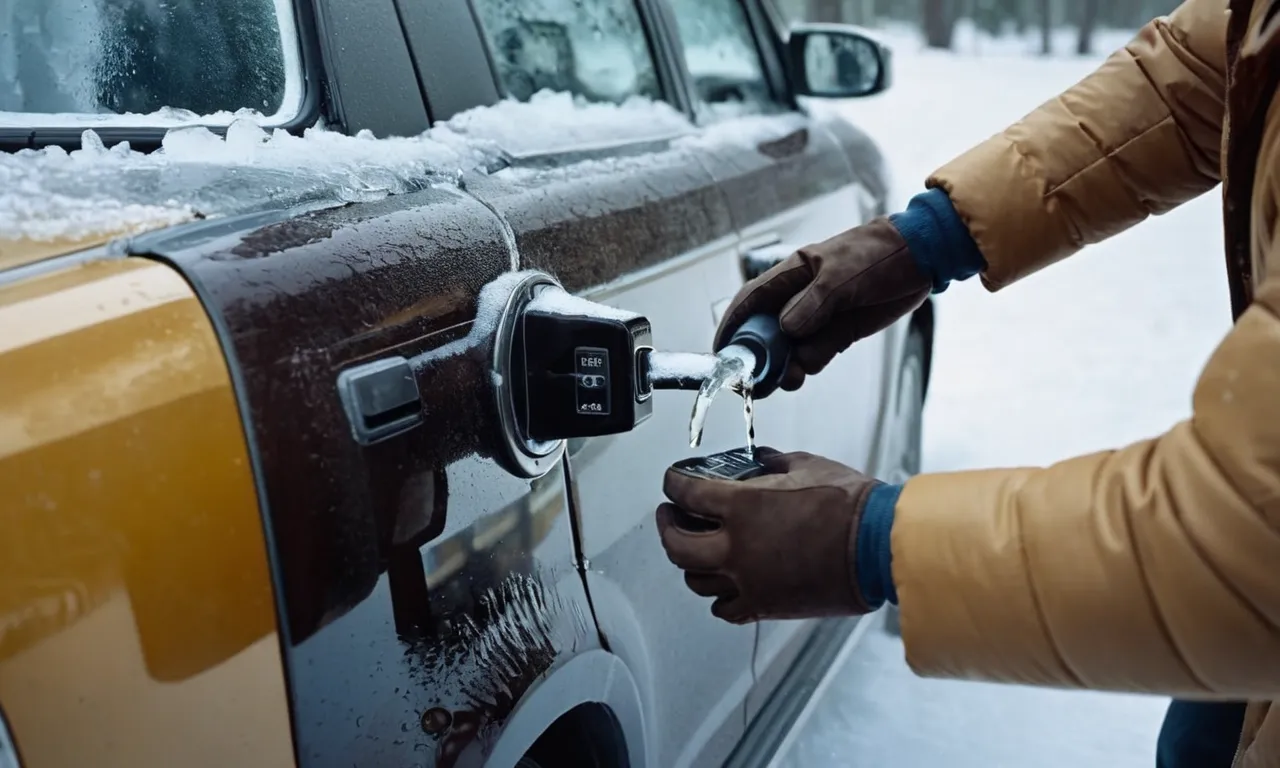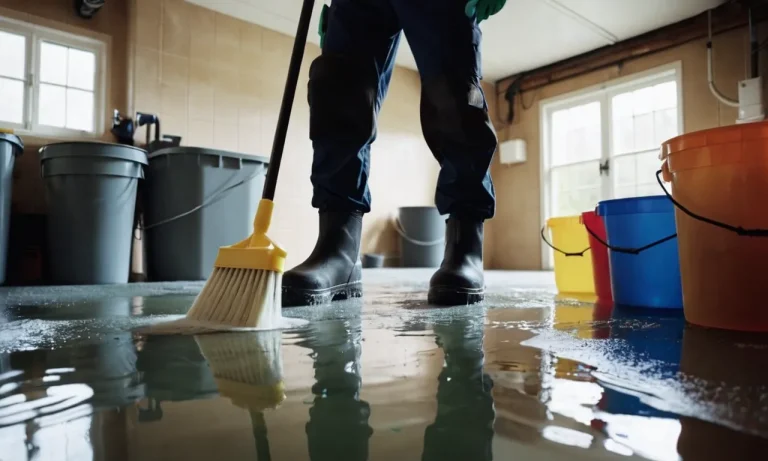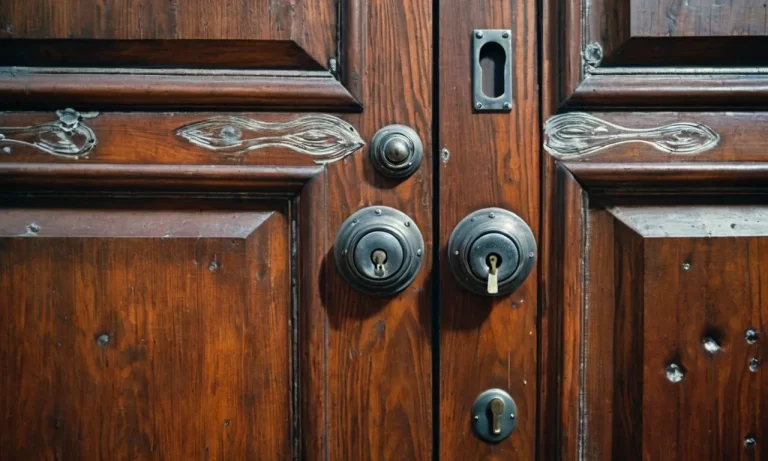How To Unfreeze A Car Door: A Step-By-Step Guide
Waking up on a frosty winter morning to find your car door frozen shut can be incredibly frustrating. If you need to get somewhere in a hurry, those precious minutes trying to pry open a frozen door can feel like an eternity.
If you’re short on time, here’s a quick answer to your question: Use a de-icing spray if available, or pour hot (not boiling) water on the edges of the door and lock area to melt the ice. Don’t force the handle or you may break it.
In this comprehensive guide, we’ll walk through all the steps needed to safely and effectively unfreeze a stuck car door, from gathering the right tools to melting the ice without damaging your vehicle. With the right technique and a little patience, you’ll be back on the road in no time.
Assess the Situation
When faced with a frozen car door, it is important to assess the situation before taking any action. This will help you determine the best course of action to unfreeze the door effectively and avoid causing any damage.
Determine how severely frozen the door is
Start by checking how severe the freezing is. If the door is completely frozen shut, it may require more time and effort to unfreeze it. On the other hand, if it’s only partially frozen, you may be able to resolve the issue more easily.
Check for visible ice
Inspect the door for visible ice. Look for ice buildup around the edges and hinges of the door. This will give you an idea of where the problem lies and help you decide the best approach to thaw it out.
Test the lock and door handles gently
Attempt to test the lock and door handles gently to see if they are frozen or not. If they are frozen, they may not move or turn as smoothly as they should. Be careful not to apply too much force, as this could cause damage to the door or the lock mechanism.
Remember, it’s essential to be patient and take your time when dealing with a frozen car door. Rushing the process or using excessive force can lead to costly repairs. If you’re unsure about how to proceed, it’s always a good idea to seek professional help.
Gather the Proper Tools
De-icing spray (preferred if available)
When it comes to unfreezing a car door, having the right tools is essential. One of the most effective tools to have on hand is a de-icing spray. This spray is specifically designed to melt ice and frost on car windows and doors.
It contains ingredients that lower the freezing point of water, making it easier to remove ice buildup. If you have a de-icing spray, it can greatly simplify the process of unfreezing your car door.
Old towels or blankets
Another tool that can come in handy when unfreezing a car door is a set of old towels or blankets. These can be used to cover the car door and provide insulation, preventing further freezing while you work on unfreezing it.
Simply place the towels or blankets over the door and secure them in place with tape or bungee cords. This will help to retain any heat you introduce and minimize the risk of refreezing.
Hot water
If you don’t have access to a de-icing spray, hot water can be a viable alternative. Fill a bucket with hot water from your home or use a kettle to boil water and carefully pour it over the frozen areas of the car door.
Be cautious not to use boiling water directly on the glass as it may cause it to crack. Hot water can quickly melt the ice and allow you to open the door. However, keep in mind that this method should be used with caution to avoid damaging the door or locks.
Hair dryer or heat gun
If you prefer a more controlled method of unfreezing a car door, a hair dryer or heat gun can be used. These tools emit hot air and can help melt the ice without the risk of introducing excess moisture.
Hold the hair dryer or heat gun a few inches away from the frozen areas and move it in a back-and-forth motion until the ice melts. It may take some time, especially for thicker ice, but the heat will eventually loosen the ice and allow you to open the door.
Plastic scraper
In some cases, a plastic scraper can be used to remove thin layers of ice from the car door. This tool is designed to be gentle on the surface of the car, minimizing the risk of scratching or damaging the paint. Use the plastic scraper to carefully chip away at the ice until the door is free to open.
Avoid using metal scrapers or tools as they can cause significant damage to the car’s exterior.
Gloves for protection
Lastly, it’s important to wear gloves when attempting to unfreeze a car door. Gloves provide protection against the cold and reduce the risk of frostbite. Additionally, gloves can provide a better grip when handling tools or applying pressure to the frozen areas.
Make sure to choose gloves that are insulating and waterproof for optimal protection.
Remember, when unfreezing a car door, it’s important to proceed with caution to avoid causing damage. If you are unsure or uncomfortable with any of these methods, it’s best to consult a professional or use alternative transportation until the door can be safely unfrozen.
Melt the Ice Gently
When facing a frozen car door, it’s important to approach the situation with caution to avoid causing any damage. Here are some steps you can take to melt the ice gently and safely:
Apply de-icer spray liberally to frozen areas if available
If you have access to a de-icer spray specifically designed for thawing frozen car doors, this can be a quick and effective solution. Simply apply the de-icer spray liberally to the frozen areas of the door, paying extra attention to the keyholes and handles.
The de-icer spray works by melting the ice, making it easier to open the door.
Pour hot water along top edges and seams of door
If you don’t have a de-icer spray on hand, pouring hot water along the top edges and seams of the door can help to melt the ice. Be sure to use hot, but not boiling water, as extreme temperatures can damage the seals or even crack the glass.
Gently pour the water along the edges, allowing it to seep into the crevices and melt the ice.
Use hair dryer or heat gun to melt ice gently
If you prefer not to use water, a hair dryer or a heat gun can be an effective alternative. Set the hair dryer or heat gun to a low or medium heat setting and aim it at the frozen areas of the door. Move the dryer or gun in a back-and-forth motion to evenly distribute the heat and melt the ice.
Remember to keep the dryer or gun at a safe distance to avoid any damage to the paint or interior of the car.
Never use boiling water as it can damage seals
While it may be tempting to use boiling water to quickly melt the ice, this can cause more harm than good. The extreme temperature of the boiling water can damage the seals around the door and even crack the glass.
It’s best to stick to hot water or alternative methods such as de-icer sprays or a hair dryer/heat gun.
Remember, it’s important to take your time and be patient when trying to unfreeze a car door. Rushing or using excessive force can lead to costly repairs or further damage. By following these steps and using gentle methods, you’ll be able to safely and effectively thaw your car door and get back on the road in no time.
Break Up Remaining Ice
Once you have successfully thawed the ice around your car door, there may still be some remaining ice that needs to be dealt with. Breaking up this ice is essential to ensure that your car door can open and close smoothly. Here are some steps to help you break up the remaining ice:
Use a plastic scraper to break up any remaining ice
A plastic scraper is the safest tool to use when trying to remove ice from your car. It won’t scratch the paint or damage the weather stripping. Gently slide the scraper along the surface of the ice, applying light pressure to break it up into smaller pieces.
Be careful not to use excessive force, as this may cause the scraper to break or damage the door.
Scrape gently near the weather stripping
The weather stripping around your car door is crucial for sealing out moisture and preventing drafts. When scraping the remaining ice, be sure to do so gently near the weather stripping. Applying too much pressure or using a metal scraper can damage the delicate rubber material.
Take your time and be patient, using the plastic scraper to carefully remove any ice in this area.
Use old towels to protect the paint if scraping vigorously
If you encounter stubborn ice that requires more vigorous scraping, it’s a good idea to protect your car’s paint. Place old towels or a blanket over the area you are scraping to act as a buffer between the scraper and the paint.
This will help prevent any accidental scratches or damage to the vehicle’s exterior.
Remember, it’s important to take your time and not rush the process. By following these steps, you’ll be able to effectively break up any remaining ice and ensure that your car door is free to open and close without any issues.
Dry Off Door and Test Opener
When dealing with a frozen car door, it is important to dry off the door and remove any excess moisture. One effective method is to use old towels and gently pat down the door. Be sure to focus on the areas where the door is frozen, such as the handle, lock, and surrounding areas.
By removing the moisture, you can prevent further freezing and make it easier to operate the door.
Operate lock and handle several times to ensure proper function
After drying off the door, it is important to test the lock and handle to ensure they are functioning properly. This can be done by operating them several times to loosen any ice that may be causing them to stick.
If the lock or handle feels stiff or difficult to move, continue to work them until they loosen up. This will make it easier to open and close the door.
Apply lubricant like WD-40 if locks are still sticky
If the locks are still sticky after drying off and testing the opener, applying a lubricant like WD-40 can help. WD-40 is a popular choice because it can effectively penetrate and loosen frozen parts. Simply spray a small amount of WD-40 into the lock and around the handle.
Then, operate the lock and handle several times to distribute the lubricant and free up any remaining ice or debris. This should help alleviate any sticking or freezing issues.
Remember, it is important to use caution when applying any lubricant, as it can be slippery. Take care not to spray excessive amounts onto the door or surrounding areas. Additionally, be sure to follow the instructions provided by the manufacturer of the lubricant you choose to use.
For more information on dealing with frozen car doors and other winter weather car maintenance tips, you can visit websites such as Popular Mechanics or Car and Driver.
Warm Up the Interior
One of the first steps to unfreeze a car door is to warm up the interior of your vehicle. This can be done by starting the engine and turning the heat on high. By doing this, you are not only warming up the car but also creating a temperature differential between the interior and exterior of the vehicle.
Start engine and turn heat on high
Start your car’s engine and let it run for a few minutes before attempting to unfreeze the car door. Turning the heat on high will help to raise the temperature inside the vehicle and thaw any ice that may be causing the door to freeze shut.
It’s important to note that you should never leave your car unattended while it is running.
Aim vents at door cracks to melt any remaining ice
Once the engine has warmed up and the heat is on high, aim the vents towards the door cracks. This will direct warm air towards the frozen areas and help melt any remaining ice. Be sure to adjust the vents so that the air is blowing directly at the door, as this will be the most effective way to thaw the ice.
You may need to experiment with different vent positions to find the best angle.
It’s worth mentioning that it may take some time for the warm air to completely thaw the ice and unfreeze the car door. Patience is key during this process. Additionally, it’s important to exercise caution when attempting to open a frozen car door.
Using excessive force or trying to pry the door open can cause damage to the vehicle. If the door remains frozen after following these steps, it may be necessary to seek professional assistance.
Prevent Future Freezing
After successfully unfreezing your car door, it’s important to take steps to prevent it from happening again in the future. Here are some useful tips to keep your car door from freezing:
Use protective cover on windshield and windows overnight
One of the most effective ways to prevent your car door from freezing is to use a protective cover on your windshield and windows overnight. This will help to keep the glass free from ice and snow, making it easier to open your car door in the morning.
There are various types of covers available on the market, ranging from simple plastic sheets to specialized magnetic covers. Consider investing in one that suits your needs and budget.
Apply silicone lubricant to weather stripping and seals
Another useful tip is to apply silicone lubricant to the weather stripping and seals around your car door. This will help to keep them pliable and prevent them from freezing. Silicone lubricant is readily available at most auto supply stores and is easy to apply.
Simply spray it onto a clean cloth and wipe it along the weather stripping and seals. This will create a protective barrier that will reduce the chances of freezing.
Park in garage or covered area when possible
If you have access to a garage or a covered parking area, make use of it during the winter months. Parking your car in a sheltered area can significantly reduce the chances of your car door freezing. The temperature inside a garage or covered area is generally higher than the outside temperature, which helps to prevent ice from forming on your car door.
If a garage or covered parking is not available, consider using a carport or parking your car near a building or wall that can provide some protection from the elements.
By following these preventive measures, you can greatly reduce the likelihood of experiencing a frozen car door. Remember, prevention is always better than having to deal with the inconvenience of a frozen car door. Stay proactive and take the necessary steps to keep your car door ice-free!
Conclusion
Dealing with a frozen car door can quickly put a damper on your day during cold winter weather. With some planning and the right technique though, you can easily conquer the ice and get on your way. The most important things to remember are to be gentle, never force the handle, use hot (not boiling) water, and thoroughly dry the door after unlocking it.
With this step-by-step guide, you’ll be prepared to take on frozen doors all winter long and start your mornings frost-free.







